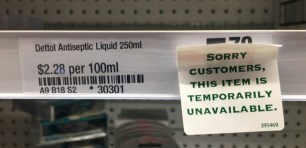
Source: SmartCompany/Reuters/Jaimi Joy.
Behind the cacophony of noise from the pharmacy sector in recent days, the reality is the pandemic has been very good for chemists.
If there was any doubt about their role as the frontline providers of healthcare in Australia, that has surely been shelved and more so than ever, as the local chemist shop has literally shown itself as the backbone of the community.
In the early days of COVID-19, GPs moved to telehealth and it was the chemist shop, open after regular business hours, dispensing the medicine. As a primary contact for many who were locked down in quarantine, the chemist sometimes stepped in to help with grocery supplies.
Nowadays it’s where you get your booster shot, and of course your rapid antigen test kit.
Yet a quick glance at the daily newspaper reveals a flurry of complaints about the time spent having to tell people there are no COVID-19 tests available and even complaints that letting supermarkets, petrol stations and the like handle supply will rob chemists of their supply.
The latter argument is a nonsense, and harks back to the Pharmacy Guild wanting to restrict the supply of chemist shops to one per 1.5 kilometres.
The frustrations are understandable and yet more evidence of lack of planning and execution by a frankly incompetent Morrison government. Every week we are told next week will be better because there are another 3 million tests becoming available, but next week never seems to come.
Most people would rather buy their test kits from a chemist because there is a sense of trust, which isn’t there when the same person is selling you petrol or cornflakes. That at least is what chemist are saying, with some considerable justification in the COVID-19 era.
As much as it may be frustrating having staff tied up telling people you don’t have any test kits, those with the tests appear to be doing quite nicely.
Last week the Australian Competition and Consumer Commission (ACCC) said the average wholesale price of rapid antigen tests was between $4 and $8 per test but ran as high as $11.45 .
The federal government provides rebates of $10 per test, so on the ACCC numbers, the chemist is making a buck before he or she puts on a retail margin.
The ACCC will be issuing another update this week but on the basis of last week’s data claims that wholesale prices are as high as $17 are yet to be supported by the regulator .
The tests are also a draw card to get people into stores, which means they may buy other over the counter items that also attract a hefty profit margin.
Chemists do have a point when it comes to vaccines, given a GP gets paid $34.55 for administering the same dose as a chemist who only gets paid $26.
This is clearly unfair to the local chemist who has proved her worth to help ease the government’s embarrassment for the delays in getting the vaccines in the first place.
Health Minister Greg Hunt has defended the indefensible by saying it is the first time pharmacies have got anything for administering vaccines, so they should be grateful for what they get. That is nonsense: pharmacies operate on longer hours and have helped fill the gaps left by the government and GP clinics, and should be paid the same money.
Next there is the issue of who is doing the complaining because in the health field it pays to know who speaks for whom.
The Pharmacy Guild is the master player long regarded as being the best lobbying outfit in Canberra.
It acts for the pharmacy owners whereas the Pharmaceutical Society of Australia speaks for pharmacists who are the trained professionals working in the shop but maybe don’t own the store.
The guild is keen on ensuring owner rights are protected by anti-competitive restrictions on supply, which is why it didn’t want Woolworths to buy Australian Pharmaceutical Industries, the owners of the Priceline Pharmacy chain.
It is also why the guild claims only chemists should be selling COVID-19 tests. If the local supermarket had people in white coats dispensing drugs many local pharmacies would struggle.
This is also why the pandemic has been a boon to chemists, justifying their frontline role in the health supply chain.
As an aside, the AMA has done a superb job in marketing itself to the government and public as the official spokesperson for doctors.
Australian Medical Association has a ring about it, but its annual report shows 16% of the members are doctors in training, 34.8% are medical students and just 45% are GPs and specialists.
By contrast, the Royal Australian College of General Practitioners has 40,000 urban and rural GPs are members and to be a GP you become part of the college.
There are 15 medical colleges in Australia. They are responsible for training of future specialists and clinical standard setting and as such are genuinely comprised of medical professions in the different fields.
Handpicked for you

How bad government decisions are forcing BlueScope customers to pay more for steel



COMMENTS
SmartCompany is committed to hosting lively discussions. Help us keep the conversation useful, interesting and welcoming. We aim to publish comments quickly in the interest of promoting robust conversation, but we’re a small team and we deploy filters to protect against legal risk. Occasionally your comment may be held up while it is being reviewed, but we’re working as fast as we can to keep the conversation rolling.
The SmartCompany comment section is members-only content. Please subscribe to leave a comment.
The SmartCompany comment section is members-only content. Please login to leave a comment.